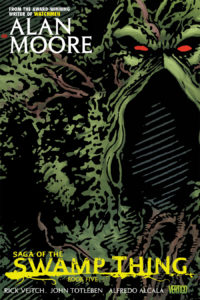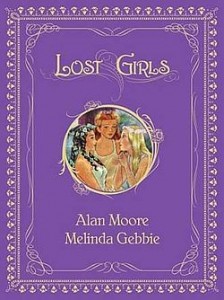Whenever folks new to comics ask for graphic novels to pick up, we tend to recommend the same ones: WATCHMEN. V FOR VENDETTA. SWAMP THING (All of which were re-branded after the fact as “Vertigo” books once the new DC imprint had been established.). It’s no coincidence that these and so many more sprang from the mind of Alan Moore, the “mad genius” of comics. There are countless things to say about Moore’s work, but perhaps the most easily overlooked thing is the man’s versatility. He can write anything, and do so with a subtlety and an almost maddening effortlessness that must make lesser writers (meaning, well, everybody else) gnash their teeth in frustration.
Moore’s work on SWAMP THING took a second-rate DC horror character and transformed it into an affecting, occasionally heartbreaking work of romance and suspense. His childhood affection for Marvelman, the British version of Fawcett’s Captain Marvel, spurred a startlingly stark and disturbing exploration of superpowers in MIRACLEMAN. V FOR VENDETTA explores Moore’s distrust of government and authority, taken to the ultimate degree, and personified in V, probably the most cheerful and likable anarchist murderer ever presented in popular fiction. And finally, acting almost as a capstone to this period of his work is WATCHMEN, Moore and Dave Gibbons’ ultimate deconstruction of the comic-book superhero, pulling in readers with a “real-world” approach, then absorbing them in a work so intricate in its storytelling devices and layered themes, that even after having read the book dozens of times, new nuances are still to be discovered upon every reading.
After a bit of a fallow period, Moore roared back to life with scores of new projects. With artist Eddie Campbell, Moore published FROM HELL, a scratchy and chilling look at the Whitechapel murders that put forth as good a theory as any about the identity of Jack the Ripper. Working for Rob Liefeld’s publishing company, Moore wallowed in his love for all things Silver-Age Superman in the SUPREME series, a book that subtly mocked and analyzed the classic comics it was at the same time paying tribute to. (Of course, Moore had already written what many consider to be the best Superman story ever in “Whatever Happened to the Man of Tomorrow?” the final appearance of the classic Silver-Age Kal-El before his post-CRISIS John Byrne revamp kicked in.)
Moore’s output took a prodigious leap forward with the creation of his own new comics imprint, AMERICA’S BEST COMICS, published through Jim Lee’s company Wildstorm (which, of course, later was purchased by DC, putting the then famously anti-DC Moore in a sticky position which never quite settled itself to Moore’s satisfaction). After a drought of new Alan Moore comics for what seemed like forever, suddenly new and absolutely wonderful series were hitting the shelves practically every week. TOM STRONG channeled the best of Tarzan, Superman, and Doc Savage in a brilliant mix of styles and themes. TOMORROW STORIES gave Moore a chance to flex his muscles with a variety of comics archetypes, most notably Greyshirt, a thinly disguised “Spirit” pastiche that let Moore really show what he could do with the eight-page short story in Eisner’s style. All of Moore’s new interests in sorcery and the psychology of “magic” showed up in PROMETHEA, and in a notion of sheer genius, Moore combined the superhero team with the storytelling style and interconnected storylines and characters of the TV cop drama in TOP TEN.
And as if all that wasn’t enough, Moore took the superhero team back to the Victorian age in LEAGUE OF EXTRAORDINARY GENTLEMEN, uniting famed characters Allan Quatermain, Dr. Jekyll, Mina Harker, Captain Nemo and the Invisible Man in several globetrotting adventures literally teeming with characters, locales and concepts from the literature of the period, so carefully and smoothly combined that the casual reader would barely notice. Moore’s most recent installment of his LEAGUE series, BLACK DOSSIER jumps ahead to the 1950s, as a rejuvenated Allan Quatermain and Mina Harker dodge familiar spies in a metafictional Great Britain in an attempt to get hold of the Black Dossier, the secret history of all the different iterations of the League that have existed over the decades. In typical Moore fashion, the book is positively packed with literary references both obvious and arcane, and there’s must be countless Easter eggs hidden within that Iwe’re nowhere near well-read enough to have caught. Still, it’s Moore and collaborator Kevin O’Neill at their best, duplicating all manner of publications from newspaper comics to government reports to Tijuana Bibles, forcing the reader to delve for meaning and create the history for themselves from these entirely fabricated “primary sources.” It’s a dense, engrossing read.
The writer courted controversy in 2006 with his massive work LOST GIRLS, an X-rated fairy-tale art book from Moore and his partner, Melinda Gebbie. Set in an Austrian hotel in 1917, LOST GIRLS follows the relationships of three women who begin to share their sexual histories (and later themselves) against the backdrop of a world sliding into global war. The women? Alice (a British high-society type), Wendy (a middle-class Londoner) and Dorothy (a Kansas farmgirl). If the names sound familiar, they should, as Moore explores these fairy tales so naturally familiar to us all, tapping into our affection and knowledge of them not merely for shock value, but to take advantage of the weight these stories carry as he casts them in a new and unsettling light. And at the same time, there’s no denying its pornographic nature, either. This is straight-out porn, with graphic depictions of sexual intercourse of just about every variation imaginable, straight, gay and otherwise. And yet, Alan Moore’s breathtaking craft elevates it to something more, a liberating and at the same time oddly poignant exploration of sexuality and how it’s both celebrated and suppressed.
Melinda Gebbie brings the best work of her career here, shifting her style and method to best fit the tone and emotional mood of each chapter, and somehow making even the most shocking acts seem quietly lyrical. As for Moore, well, what can you say? It’s Alan Moore. He spins touching, poetic dialogue like thread from a wheel, all the while suffusing it with meaning and import that doesn’t hit you until pages later. Moore also cleverly paces the story, slowly ratcheting up the sexual content with each successive volume, until the final chapters, which contain some of the most graphic and controversial material, at which time the reader has become so immersed in the “taboo” material that you’re able to look past it to what the story is really about: the fragility of life in an uncertain world, and the all-too-human need to look to another for fleeting moments of pleasure.
Any one of these books would be enough to cement a writer’s reputation. The fact that they’re all the work of a single man is staggering.



Comments are closed.